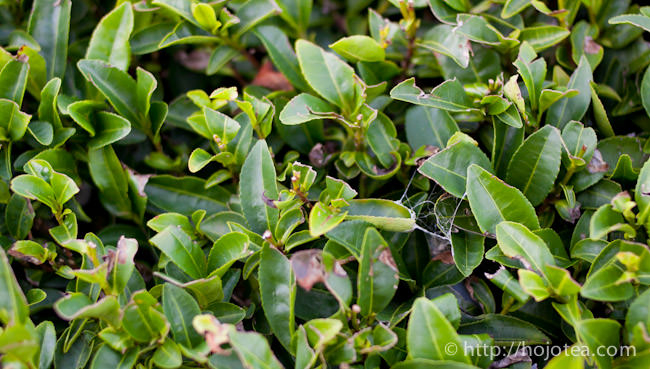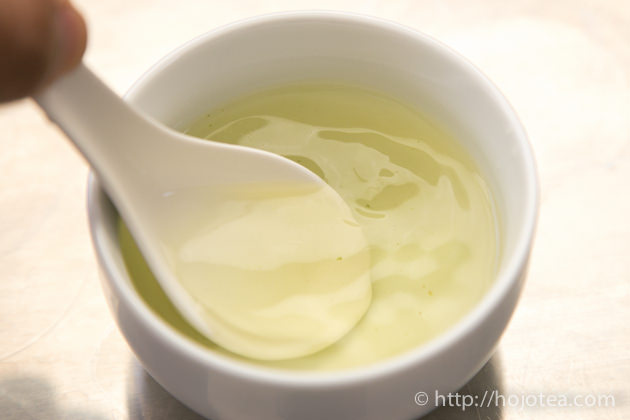- HOME >
- Types of Tea
Asamiya Sencha, the rare Japanese green tea that gives full body
- [2014.12.23] Posted By Akira Hojo
Asamiya sencha (朝宮煎茶) is from Shigaraki, Koga city in Shiga prefecture. Asamiya is the district that belongs to Shigaraki town.The taste of Asamiya sencha is very rich, full body and it gives lingering sweetness on our palate. In fact, full-body character is extremely rare for Japanese green tea.
Asamiya is gifted place with special clay
The reason why the Asamiya sencha gives strong body is due to the soil condition. In Japan, Shigaraki is one of the 6 famous kilns. The clay in Shigaraki is rich in alkaline minerals such as potassium and calcium. The Shigaraki clay is used for making various types of tea ware throughout the history.
Shigaraki area used to be the bottom of the old Biwa Lake
The Shigaraki area used to be at the bottom of the lake back in a few million years ago. The position of the lake moved to the north afterwards when there was further crustal movement. In Japan, the ancient lake situated around Shigaraki or Iga area is called Kobiwako(古琵琶湖): Ko means old and Biwako means Biwa Lake (琵琶湖).If tea is grown in the soil with rich mineral content, no doubt that it will be reflected in its taste.
Many brands of Sake produced in Shigaraki give full body character
As a matter of fact, not only the tea from Asamiya is rich in body, rice, vegetable and even Sake from these areas gives full body characteristic. If you have any chance to visit Japan, I suggest you to look for the sake that is made in either Shigaraki or Iga. The sake from these areas is less expensive, yet it gives very deep after taste as well as full body. The good things are often less popular. One of our clay teapot line-ups, called Kobiwako clay teapot, is also from these areas. Thanks to the clay collected at the bottom of the lake, the taste of tea is very rich if we brew it in Kobiwako clay.
The most Japanese green tea lost body during the process
In Japan, extremely less tea gives full body character. It is because of distorted quality criteria in Japan. Japanese does care a lot about the appearance. Most of Japanese teas are processed with colour sorting machine in order to completely remove the stems.
The manufacturers in Japan do not like to see the stem as it gives a contrast in colour. After removing the stem, the colour of tea leaves becomes homogeneous. The manufacturer feels the homogeneous colour looks more beautiful and it is supposed to be the appearance of a good tea. However, the function of stem in taste is much more important than their imagination.
A stem contributes in the sweetness, body and richness in taste
Have you ever tried the tea called Karigane or Bocha? These are the tea that only consists of tea stems. Surprisingly the taste is very rich in body and you may enjoy the fullness of the sweetish taste on your palate. This sweetness comes from the specific type of mineral exists in stems, such as calcium. If you imagine eating some vegetables such as spinach, celery or any brassica plant, do not you think that the stem is sweeter than the leaf? You may feel that the white-pale part of spring onion is sweeter than the green leaf too. It is because that in the plant metabolism the calcium only reaches until the stem. If tea contains no stem, the taste of the tea also becomes too clear and transparent. In fact, the stem was not removed before in Japan. Our parent used to tell us that we have good luck if the stem of tea stands up in our cup of tea. For now, we will never find any stem in our cup. Considering the above facts, we purposely did not remove the stem of tea. As a result, the tea gives extra body and fuller taste on our palate.
Deep after taste thanks to the natural farming practice
The Asamiya sencha that we introduced is made from the naturally farmed tea. It is also from the Zairai variety. The Zairai variety means the tea tree is planted from seed. The root is deeper and longer than the cultivated tea like Yabukita. The flavour of Asamiya Sencha is very clear, slight floral note with a hint of sweet nutty flavour and also a little fruity. It reminds me of young grapes or citrus fruit.
Related Articles
How to get the latest update on HOJO?
1. Follow Twitter, 2. Click "Like" on Facebook, and 3. Subscribe in newsletter. You can have the latest tea news from HOJO.
 Subscribe the Newsletter to enjoy the privileges
Subscribe the Newsletter to enjoy the privileges- You may receive a free sample upon purchase, or you may have the priority to purchase special products. So please remember to subscribe our newsletter as well as the social network.
- Myanmar White Tea Bud 2013 from Guo Gan, Myanmar
- We have released a raw Pu-erh tea, 緬甸白芽茶 2013 (Myanmar White Tea Bud 2013), produced by ethnic minorities in t …
- Yong De Wild White Tea 2025 Loose Leaf Limited Release
- We have released Yong De Wild White Tea Loose 2025. For the 2025 harvest, only the loose-leaf type was …
NEW ARTICLES
 Myanmar White Tea Bud 2013 from Guo Gan, Myanmar
Myanmar White Tea Bud 2013 from Guo Gan, Myanmar- We have released a raw Pu-erh tea, 緬甸白芽茶 2013 (Myanmar White Tea Bud 2013), produced by ethnic minorities in t …
 Yong De Wild White Tea 2025 Loose Leaf Limited Release
Yong De Wild White Tea 2025 Loose Leaf Limited Release- We have released Yong De Wild White Tea Loose 2025. For the 2025 harvest, only the loose-leaf type was …
 Experience the True Freshness of Raw Pu-erh : Tang Jia 2025 Loose Leaf Release
Experience the True Freshness of Raw Pu-erh : Tang Jia 2025 Loose Leaf Release- We have released Tang Jia Raw Pu-erh Tea 唐家古樹生茶 2025 Loose Leaf. Among HOJO’s raw pu-erh teas, Tang Jia Raw Pu …
 Yunnan Chun Jian Green Tea from High Mountain Gardens
Yunnan Chun Jian Green Tea from High Mountain Gardens- Yunnan Chun Jian Green Tea is now available. This tea is made from naturally grown leaves harvested from high …
 Limited Loose Leaf Release of 2025 Da Xue Shan Wild Raw Pu-erh Tea
Limited Loose Leaf Release of 2025 Da Xue Shan Wild Raw Pu-erh Tea- We have released the 2025 loose-leaf version of Da Xue Shan Wild Raw Pu-erh Tea. This tea comes from wild tea …
 Discover a New Way to Enjoy Tea: Cooking Rice with Tea
Discover a New Way to Enjoy Tea: Cooking Rice with Tea- Cooking rice with tea is a simple idea, but it brings surprisingly satisfying results. The tea’s flavour seeps …
 2025 Da Xue Shan Wild White Tea Now Available from Yunnan
2025 Da Xue Shan Wild White Tea Now Available from Yunnan- The 2025 harvest of Da Xue Shan Wild White Tea is now available. Crafted from truly wild Camellia taliensis tr …
 Fresh 2025 Yunnan White Tea – Select Your Favourite Lot Before Blending
Fresh 2025 Yunnan White Tea – Select Your Favourite Lot Before Blending- Freshly crafted in Yunnan and just arrived in KL, our new 2025 white tea is now available at our Gardens Mall …
 2024 Dong Shan Raw Pu-erh Tea – Crafted with the Producer for Desired Quality
2024 Dong Shan Raw Pu-erh Tea – Crafted with the Producer for Desired Quality- We have released the 2024 cake of Dong Shan Raw Pu-erh Tea. Earlier, we offered the loose-leaf version from th …
 Development of Firewood Roasted Hojicha Using Naturally Grown Tea from Yunnan
Development of Firewood Roasted Hojicha Using Naturally Grown Tea from Yunnan- We are currently staying in Yunnan Province for tea production. As the season nears its end, tea trees with pa …
Category
- New Arrival at HOJO Online Shop
- Featured Articles
- Newsletter
- Types of Tea
- Origin of Tea
- Teapot and Tea Equipment
- Tea Column
- How to enjoy tea
- Tea Processing
- How to choose quality tea
- Tea constituents and functional effect
- Safety of Tea
- Foods
- Tea Business Operation
- Hobby and Outdoor Activity
- Ranking of Tea
- Video
- FAQ
- Media Release
Profile

- AKIRA HOJO
- I invite you to experience my tea selections.I was born in Nagano, Japan. In university, I studied agricultural chemistry, and I have the master degree in food science. I worked in Japanese food industry for 10 years. I involved in R&D, QC and QA. As a factory manager, I implemented ISO9000 series and managed the factory.
- The Art of Tea Magazine
- We posted the article on “The Art of Tea Magazine No.9, the magazine is published in Taiwan. We featured …
- New Straits Times
- The Malaysian National Newspaper, New Straits Times featured HOJO Tea on 17-Oct-2007.
Shop Info

Address:Lot No. T-215, 3rd Floor, The Gardens Mall, Mid Valley City, Lingkaran Syed Putra, 59200 Kuala Lumpur
Tel: +603-2287-4537
Business Hour: 10am to 10pm


















